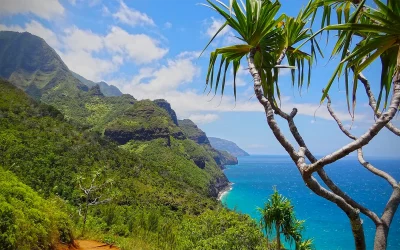Essential Solo Female Traveler’s Safety Guide

Safety for Solo Female Travelers
I want start out by emphasizing that traveling solo as a woman isn’t nearly as dangerous as some people claim. Sometimes I feel that there are more fearmongers than criminals in this world.
I’ve been traveling solo as a woman for over 20 years, including numerous trips to South Africa, and I can tell you the world isn’t nearly as dangerous as some people seem to think. But there is no harm in taking some safety precautions, to make sure you have an unforgettable and stress-free experience, wherever you are going.
In this Solo Female Traveler’s Safety Guide, I am equipping you with essential safety tips and strategies, to make sure your solo adventures are as secure as they are exhilarating. This guide is designed for both the first-time solo female travelers and the seasoned wanderer. It offers insights that will empower you to travel smarter, safer, and with greater confidence.
The Importance of Preparation
Preparation is the cornerstone of a safe travel experience. Start by immersing yourself in some research about your intended destination. You could start by checking the following:
- The travel advisories : These provide information about any travel warnings for your destination
- CDC: For information about the vaccinations you might need.
It helps if you understand cultural norms, local customs, and the legal aspects unique to your destination. Being well-informed not only minimizes risks, but also enriches your travel experience.
Travel Insurance
Another critical component of your travel prep should be selecting the right travel insurance.
Look for policies that offer comprehensive coverage including medical emergencies, trip cancellations, and baggage loss. Ensure your insurance covers the activities you plan on doing, such as skiing, scuba diving, and similar adventures. Having the right insurance can be a lifesaver in scenarios you might not anticipate.
Setting up a Communication Plan
Another key aspect of your preparation is setting up a reliable communication plan. Share your itinerary with close friends or family and establish regular check-in times. Especially if you are going on long hikes or go off the grid. This ensures someone always knows your whereabouts and can alert authorities if you’re unreachable or don’t return within the discussed timeframe.
If you are really going off the beaten track, like going on a road trip through Botswana, where you might not have signal for days and help is not readily available, you might want to buy or rent a satellite phone. Yes, it is expensive, but it can be a lifesaver.
My car once broke down in Kenya on a muddy back road that was not traveled on much, and I had no network, so I was VERY happy I had a satellite phone on me.
Know Your Local Emergency Numbers
Familiarize yourself with local emergency services in your destination. Know the direct numbers for police, medical services, and your country’s embassy or consulate.
In some countries, these services might be reached through different numbers, so having this information readily accessible is crucial. Save these numbers in your phone before you depart.
Smart Packing for Safety
Your backpack or suitcase is more than just luggage; it’s your mobile safety kit.
Pack essentials like:
- First Aid Kit
- Power Bank
- GPS tracker (or download a GPS app; they work without a network as long as you download the map beforehand)
- Any medication you need, your medication might not be available where you are going
Clothing to Blend In
While packing, think about how you can blend in at your destination. This might mean adapting your wardrobe to match local customs. However, don’t compromise on comfort and functionality. For instance, comfortable shoes are a must for long walks, and layers are practical for changing climates or keeping mosquitos at bay in the evening.
And please, leave your expensive jewellery at home. The most common type of crime is petty crime like snatching a necklace or your phone, especially in cities and this can be often be easily avoided.
Staying Safe on the Go
Choosing the right accommodation is key when it comes to safety. Opt for well-reviewed and reputable places, whether it’s a hotel, hostel, or Airbnb. If you are staying in a city or neighborhood that isn’t exactly known for safety, check for specific safety features like 24-hour reception, security cameras, and in-room safes.
Keep your room locked and latch and/or block it from the inside if you feel unsafe.
I always check before booking if I can get to my accommodation safely and easily at night, especially in high risk countries. If walking through narrow dark alleyways for half an hour in the dark is the only way to get to your hotel, just pick another hotel that is more accessible. That extra 10 dollar difference just isn’t worth the risk.
Safe Transportation
Navigating transportation safely is equally crucial. Research the most reliable and safe way to get around at your destination, since there are such differences in safety levels per country. The things you can safely do in South East Asia, might not be so safe in South Africa. That doesn’t mean you shouldn’t go to South Africa (please do, it’s so beautiful), you just make different choices when it comes to safety precautions.
For taxis, opt for registered services and avoid accepting rides from random individuals at the airport; use the taxi desk if available.
When you use apps like Bolt or Uber, make sure you get in the right Uber (let them confirm your name and check the license plate), share your ride progress with a friend through the app, and always have a map handy (pre-downloaded Google maps are a good option) so you know where you are going. Also avoid sharing travel plans or accommodation details with strangers.
Watch Your Belongings
Be mindful of your belongings, especially in crowded places. Use anti-theft bags or keep your valuables securely attached to your person. Also consider buying a RFID Data Theft Protection wallet, to protect your cards from being skimmed.
Stay aware of your surroundings, especially in tourist-heavy areas where pickpockets are common.
On the beach, consider taking a waterproof pouch, so you can take your phone and bank card when you go for a swim.
Handling Emergencies
Despite the best preparations, emergencies can happen. Whether it’s a lost passport, a medical emergency, or an unexpected natural disaster, knowing how to respond is vital.
Keep a digital copy of important documents like your passport, travel insurance, and visas in a secure cloud service. This can be a lifesaver if your physical documents are lost or stolen.
If you face a health emergency, it’s crucial to know where to find the nearest clinic or hospital. Carry a basic first-aid kit for minor injuries and always have a list of any allergies or medical conditions easily accessible.
In case of theft, report it immediately to the local police. Having a secure online backup of your credit card information and your bank’s emergency number can help you in quickly blocking lost or stolen cards. Knowing how to contact your country’s embassy or consulate can provide an additional layer of support in such situations.
Safety During Road Trips

Now this is something where I have experienced multiple times that preparation is everything!
- Know how to change a tire. I’m ashamed to admit that I changed my first tire in South Africa, with the help of a YouTube video I downloaded beforehand. I was very happy with that download though, because there was nobody around to help me.
- Have offline or GPS maps downloaded beforehand, you might not have network everywhere
- Carry a satellite telephone if you’ll be driving in areas without network for very long stretches (think of places like the Kalahari desert) and where you don’t expect a lot of other travelers. Again, this is something I experienced first hand: I was in a remote area in Kenya without cell phone network when the car broke down, I was so happy that I rented a satellite phone for that trip.
- Carry enough water to last a few days
- If you are renting a 4×4 and don’t have any experience with a 4×4, consider doing a 4×4 course beforehand
- If you’ll be driving a 4×4 and going off-road through deep sand or mud, know how to get your car unstuck (YouTube downloads and proper equipment are your friends). Again: been there, done that. The times I was stuck, I felt so proud afterwards, when I managed to get myself unstuck.
- In some countries, driving at night isn’t safe. Think: potholes larger than a pool, cattle or wildlife in the road, pedestrians on the highway, or crime-related incidents that might be more common at night. Research beforehand if it’s safe to drive at night.
Be Friendly but Cautious
Interacting with locals and fellow travelers is part of the enriching experience of solo travel. However, it’s important to trust your instincts. Be friendly but cautious. Avoid sharing too much personal information, and be wary of unsolicited help or overly friendly strangers, as these could be ploys for scams.
Conclusion Safety Solo Female Travelers
It’s empowering to embark on a solo journey as a female traveler. This guide isn’t meant to instill fear, there is enough of that going around, but to prepare you for a safe and enjoyable travel experience.
Remember, the world is far more friendly and accommodating than it is dangerous. With these safety tips and strategies in your traveler’s toolkit, you are well-equipped to navigate the globe independently and confidently.
As you set off on your solo adventures, embrace each experience, from the triumphant to the challenging. Every journey is a new chapter in your personal story, filled with lessons and memories to cherish. We hope this Solo Female Traveler’s Safety Guide serves as your companion in your travels, ensuring that each journey is as safe as it is unforgettable. Bon voyage, adventurous souls!
Looking for a safe destination for your next solo trip? Take a look at the article Best Solo Travel Spots for inspiration.
FAQs Safety Solo Female Travelers
Where is the safest place for a woman to travel alone?
Countries like Japan, Canada, New Zealand, and Scandinavian nations are among the top safe destinations for solo female travelers, due to their low crime rates and friendly cultures.
What is the safest city for solo female travelers?
Cities like Tokyo, Singapore, Reykjavik, and Vienna are known for their safety, efficient public transport, and welcoming atmosphere for solo female travelers.
How can a woman travel alone safely?
To travel safely, research your destination, stay in well-reviewed accommodations, keep family informed of your itinerary, be aware of your surroundings, and trust your instincts.
Which country is best for solo female travel?
Countries like New Zealand, Canada, Japan, and Portugal are great for solo female travelers due to their safety, ease of travel, and friendly locals.
What is the safest country for solo female traveler in Asia?
Japan and Singapore are often considered the safest countries in Asia for solo female travelers, offering a mix of culture, safety, and efficient transportation.
What are the safest places for solo female travelers in Europe?
Scandinavian countries, along with Austria, and Switzerland, are known for their safety, friendly locals, and ease of getting around.
What are the safest places for solo female travelers in South America?
Chile and Uruguay are generally considered safe options in South America, with friendly cultures and beautiful landscapes.
What are the cheapest and safest places to travel alone?
Countries like Thailand, Vietnam, Portugal, and Costa Rica are known for being both affordable and safe for solo travelers, offering a blend of culture, natural beauty, and friendly locals.

Written by Stefanie
More From This Category:
Best Solo Travel Spots: Discover These 11 Amazing Places
Best Solo Travel Spots: Discover These 11 Amazing PlacesAre you dreaming of going on a solo trip, but not sure where to start? Look no further! This guide is your gateway to discovering the best solo travel spots across the globe. From the bustling streets of Tokyo to...
Best Time to Visit Iceland for Aurora Borealis: A Magical Guide
Best Time to Visit Iceland for Aurora BorealisDiscover the awe-inspiring Aurora Borealis in Iceland, a natural spectacle that lights up the Arctic sky. This guide provides key insights into the best time to visit Iceland for Aurora Borealis, ensuring you maximize your...
Unlocking Paradise: Your Guide To The Best Hawaii Island Visit
Best Hawaii Island Visit: Your Guide to Unlocking Paradise Discover your ideal Hawaiian paradise on the best Hawaii island visit based on your interests and budget. The Big Island is a natural wonderland with volcanoes and starry skies. Maui combines luxury and...




0 Comments